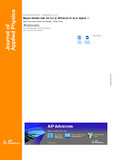| dc.contributor.author | Juma, Albert | |
| dc.contributor.author | Wafula, Henry | |
| dc.contributor.author | Wendler, Elke | |
| dc.contributor.author | Dittrich, Thomas | |
| dc.date.accessioned | 2023-07-06T11:23:09Z | |
| dc.date.available | 2023-07-06T11:23:09Z | |
| dc.date.issued | 2014-02-03 | |
| dc.identifier.uri | https://doi.org/10.1063/1.4864125 | |
| dc.identifier.uri | https://pubs.aip.org/aip/jap/article/115/5/053703/373750/Meyer-Neldel-rule-for-Cu-I-diffusion-in-In2S3 | |
| dc.identifier.uri | http://ir-library.mmust.ac.ke:8080/xmlui/handle/123456789/2259 | |
| dc.description.abstract | The nature of barriers for atomic transport in In2S3 layers has been varied by addition of chlorine. Diffusion of Cu(I) from a removable CuSCN source was used to probe the variation of the barriers. The Meyer-Neldel (compensation) rule was observed with a Meyer-Neldel energy (EMN) and a proportionality prefactor (D00) amounting to 40 meV and 5 × 10−14 cm2/s, respectively. D00 shows that the elementary excitation step is independent of the specific mechanism and nature of the barrier including different densities of Cl in In2S3. The value of EMN implies that coupling of the diffusing species to an optical-phonon bath is the source of the multiple excitations supplying the energy to overcome the diffusion barriers. | en_US |
| dc.language.iso | en | en_US |
| dc.publisher | Journal of Applied Physics | en_US |
| dc.subject | Meyer-Neldel, rule, Cu (I), diffusion, In2S3 ,layers | en_US |
| dc.title | Meyer-Neldel rule for Cu (I) diffusion in In2S3 layers | en_US |
| dc.type | Article | en_US |

